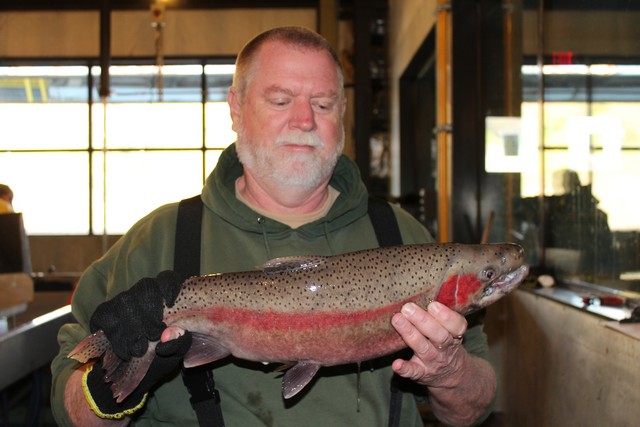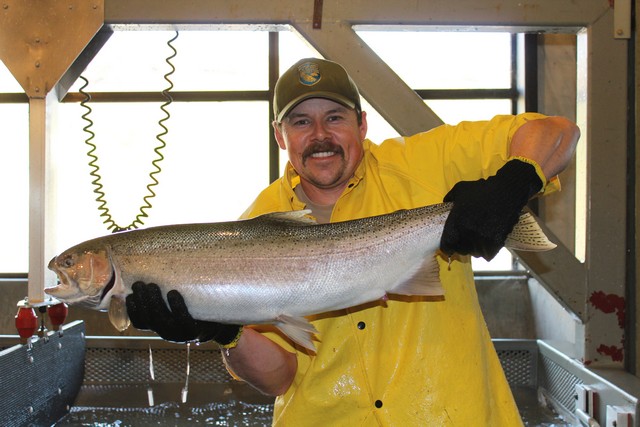Three separate strains of fish – the Eel River strain of American River steelhead, the Coleman Hatchery steelhead strain and Central Valley hatchery steelhead of undetermined origin – are returning to the American River this year, as evidenced in a trip that I made to the Nimbus Fish Hatchery on January 30.
The hatchery staff sorted through the fish as I watched them and took photos. The only fish the staff spawned during the season or put in the holding ponds for spawning over the next couple of weeks were the Eel River strain fish, characterized by their big silvery sides and slender bullet shapes.
The staff released both Eel River strain and the Central Valley fish back into the river. Meanwhile, they killed the Coleman strain fish, obtained from Battle Creek at Coleman National Fish hatchery, as part of a study to see how the fish fare in the American.

The reason for the current study of the Coleman fish goes back to 2008, when NOAA Fisheries issued a biological opinion requiring that fishery managers look at appropriate local Central Valley stocks for possible introduction into the American River, in order to reduce straying
The biological opinion also urged fishery managers to explore reintroducing steelhead and salmon above rim dams into the headwaters where the fish used to spawn, including on the American River below Nimbus.
Before Folsom Dam, salmon and steelhead ascended into North, Middle and South Forks of the American to spawn. As late as 1944, 1945 and 1946, the Department documented spring run Chinook salmon ascending the fish ladder at the old Folsom Powerhouse, according to Dr. Robert Titus, fishery scientist, in a presentation for the Save the American River Association in December 2013.
Jay Rowan, Acting Senior Hatchery Supervisor for CDFW’s North Central Region, emphasized, “We have NO plans to get rid of the current Eel River steelhead strain. This is an exploratory phase only, since they may not come back to the river in numbers anyway (or otherwise be appropriate) for the system. For now, we will continue spawn and rear the Eel River strain. “
According to studies done on the projected impacts of the dam before it built, officials determined that an annual production of 430,000 steelhead yearlings and 4 million fall Chinook salmon smolts would be needed to mitigate for the dam.
However, after just hundreds of the river’s steelhead returned to Nimbus Fish Hatchery in the first few years after Folsom Lake was completed, the CDFW decided to introduce Eel River-strain steelhead to the hatchery, boosting annual steelhead returns to the hatchery in the thousands in the good years.

Limited analyses conducted since then indicate steelhead from both the hatchery and the river are genetically more similar to Eel River steelhead than other Central Valley steelhead stocks.
Since the first stock that they decided to study was the Coleman-strain of fish, brought 3 years ago as eyed eggs from the Coleman National Fish hatchery. The CDFW released 170,000 Coleman Fish Hatchery eggs in 2014, the worst year for steelhead returns on American since Folsom Dam was built. The fish are marked with coded wire tag to indicate they part of the study.
“These fish began to come back this season, earlier than the Eel River strain,” said Rowan. “We wanted to see if these fish survived, went to the ocean and would come back to the hatchery.”
However, as it turned out, the Coleman fish studied so far had bacteria present that could potentially cause a fish disease, bacterial kidney disease.
“Once the disease is in the fish hatchery, it’s difficult to get it out,” said Rowan, “so it is not known whether we will put release more Coleman fish to study in future years. “Planting the fish again this year is definitely out.”
Acoustic tags track the fish on the ocean. When the fish are taken at the hatchery, the scientists study the otoliths (ear bones) chemical signatures and scales to see if they have been to the ocean. To do this, the fish must be killed, so unlike Eel River and other Central Valley fish, they are not returned to the river alive.
The next area the CDFW plants to explore is seeing if it is possible to develop a hatchery brood stock from the wild rainbows that inhabit the river forks above Folsom Dam. There are currently 2 to 3 pound rainbows, landlocked steelhead, that appear to be the same genetic strain of fish that used to ascend the river below Folsom Dam was built, according to Rowan.

“Our next step after the Coleman study will be looking upstream for the genetic brood stock of those fish. There are clearly remnants of trout that historically steelhead in the river system. The question is: Do they still have the genes that make them want to express their anadromy? If they are running down to the lake and using it like they would the ocean, maybe it would work” he said.
Another challenge in reintroducing the steelhead to the lower river below the dam would be acquiring enough wild trout to even create a brood stock, since these fish scatter throughout the forks and tributaries, noted Rowan.
When I was a kid in the sixties, during the winter there was a landlocked steelhead fishery at Folsom Lake. Anglers would drive their cars and trucks down to the water, sit in their vehicles and wait until they got a bite. You would see stringers in the water with bright landlocked steelhead ranging from 16 to 22 inches long.
Meanwhile, the Eel River strain continues to provide a prized trophy steelhead fishery right in the heart of a major metropolitan area. During the spawning session I attended, one female weighing an estimated 17 to 18 pounds was spawned, along with a male weighing an estimated 14 pounds.
In fact it was the best day of the year so far for American River fish, as evidenced by the 161 adult Eel strain steelhead that hatchery staff sorted, spawned or returned to the river. They also returned another 75 “green” fish – those not yet ready for spawning – back to the river, according to Gary Novak, hatchery manager.
These steelhead are apparently two-year-old fish – fish that have spent one year in salt – or four-year-old fish – fish that have spent three years in salt. Missing from the hatchery returns are the three-year-old fish that normally make up the bulk of the river fishery.
This is because the lowest number of fish that ever returned to the hatchery, just 154, returned in 2014. To make matters worse, because of temperature problems at the hatchery, they had a choice of keeping the fish in the hatchery, where they would likely die, or release early into the river, where they might have a chance of survival.
They were released at 188 to the pound. However, only two of the fish that were released early in April and May of 2014 have returned.
Hatchery staff also killed 12 Coleman fish, all adults, and put them on ice in a bucket while I was there. A total of 194 Coleman fish have returned to the facility this winter, noted Novak. These fish were smaller, fatter and more brightly colored than the Eel River fish.
They also returned 6 Central Valley strain back into the river for anglers to hook. So far this season, they have trapped and released 261 Central Valley steelhead.
The thing that surprised me most was the large number of late run Chinooks that are showing this winter. The hatchery workers took fifteen salmon into the hatchery, including two that appeared to be in the 30 to 40 lb range.

“Normally we don’t see any salmon this time of year,” Novak said. “Last week we saw 70 salmon at the hatchery.”
Novak also noted that the river water temperature has been 45 degrees, the coldest it’s been in fifteen years. Forty-eight degrees is normal for this time of year, and the water gets progressively warmer, into the fifties, as the winter proceeds.
The hatchery has received just 200,000 eggs so far this season to meet its production goal of 425,000 smolts, but hopefully will get more fish to reach its goal.
“We will continue to spawn this winter as long as we receive viable number of fish,” said Novak.
Meanwhile, rain and snow continues to pummel the American River watershed and northern California. The Bureau of Reclamation increased releases into the American River below Nimbus Dam from 55,000 cfs to 70,000 cfs on February 9 to accommodate runoff from the latest storms.
